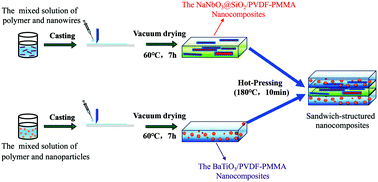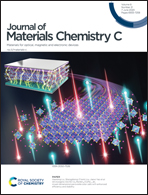Achieving high energy density and discharge efficiency in multi-layered PVDF–PMMA nanocomposites composed of 0D BaTiO3 and 1D NaNbO3@SiO2†
Abstract
The choice of dielectric fillers and structure design play an important role in improving the energy storage properties of polymer-based nanocomposites. In this work, a class of sandwich-structured poly(vinylidene fluoride) (PVDF)-based nanocomposites with an insulating layer containing 1D NaNbO3@SiO2 nanowires was prepared using simple casting and hot-pressing methods. 1D NaNbO3 nanowires coated with a SiO2 insulating layer were introduced into the polymer matrix to form a central layer, which has high insulation and low dielectric permittivity. Consequently, the sandwich-structured nanocomposites with 9 vol% 0D BaTiO3 nanoparticles and 1 vol% 1D NaNbO3@SiO2 nanowires exhibit a high discharge energy density of ∼20 J cm−3 at 450 MV m−1 as well as a high discharge efficiency of 75%, indicating a combination of high energy density and high efficiency compared with the systems of all-polymer composites or polymer-based nanocomposites. The dielectric analyses and simulation results indicate that the improved energy storage density and discharge efficiency are attributed to the effect of insulating layers containing 1D NaNbO3@SiO2 nanowires. The findings of this work demonstrate that introducing insulating layers containing 1D nanofillers with high insulation and low permittivity can have a positive effect in improving energy storage performance of dielectric polymer-based nanocomposites.



 Please wait while we load your content...
Please wait while we load your content...